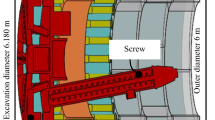Abstract
This paper studies the effect of multiple geometric parameters of a micronozzle on a MEMS solid propellant thruster (MSPT) and establishes a quantitative optimisation model. Influences of the structural parameters of the micronozzle on performance are accurately calculated. The significance and contribution ratio of each parameter are evaluated by F distribution. Correspondingly, a horizontal MSPT is fabricated and tested to prove the optimisation model. In the implementation, a complete microigniter is formed by a single layer of Au, achieving an ultra-low ignition voltage of 2.1 V with an extremely low ignition resistance of 4 Ω.
















Similar content being viewed by others
References
Ahn J, Lee D (2013) Computational prediction of the thrust characteristics of a small thruster at low pressure condition. 49th AIAA/ASME/SAE/ASEE joint propulsion conference and exhibit, p 3908
Bayt R (1999) Analysis, fabrication and testing of a MEMS-based micro propulsion system. Aerospace Computational Design Laboratory, Dept. of Aeronautics & Astronautics, Massachusetts Institute of Technology
Bruccoleri A, Leiter R, Drela M et al (2012) Experimental effects of nozzle geometry on flow efficiency at low reynolds numbers. J Propul Power 28:96–105
Cheah KH, Chin JK (2011) Performance improvement on MEMS micropropulsion system through a novel two-depth micronozzle design. Acta Astronaut 69:59–70
Cheah KH, Koh KS, Chiang CL et al (2011) Progress on development of Al2O3-SiO2 ceramic MEMS-based monopropellant micropropulsion system. 47th AIAA/ASME/SAE/ASEE joint propulsion conference and exhibit, p 5923
Chen H, Zhang Y, Zhang M et al (2013) Performance prediction of conical nozzle using Navier–Stokes computation. 49th AIAA/ASME/SAE/ASEE joint propulsion conference and exhibit, p 3733
Docker PT, Kinnell PK, Ward MCL (2004) Development of the one-step DRIE dry process for unconstrained fabrication of released MEMS devices. J Micromech Microeng 14:941–944
Esper J, Neeck S, Slavin J et al (2003) Nano/micro satellite constellations for earth and space science. Acta Astronaut 52:785–791
Hitt D, Zakrzwski C, Thomas M (2001) MEMS-based satellite micropropulsion via catalyzed hydrogen peroxide decomposition. Smart Mater Struct 10:1163–1175
Köhler J, Bejhed J, Kratz H et al (2002) A hybrid cold gas microthruster system for spacecraft. Sens Actuators A 97–98:587–598
Lee J, Kim T (2013) MEMS solid propellant thruster array with micro membrane igniter. Sens Actuators A 190:52–60
Lee J, Kim K, Kwon S (2010) Design, fabrication, and testing of Mems solid propellant thruster array chip on glass wafer. Sens Actuators A 157:126–134
Lewis D Jr, Janson S, Cohen R (2000) Digital micropropulsion. Sens Actuators A 80:143–154
London A, Ayón A, Epstein A et al (2001) Microfabrication of a high pressure bipropellant rocket engine. Sens Actuators A 92:351–357
Louisos WF, Hitt DL (2011) Transient analysis of supersonic viscous flow in 3D micronozzles. 41st AIAA fluid dynamics conference and exhibit, p 3996
Sathiyanathan K, Lee R, Chesser H et al (2011) Solid propellant microthruster design for nanosatellite application. J Propul Power 27(6):1288–1294
Seo D, Lee J, Kwon S (2012) The development of the micro-solid propellant thruster array with the improved repeatability. J Micromech Microeng 22:094004
Shen Q, Yuan W, Li X et al (2013) A fully decoupled design method for MEMS microthruster based on orthogonal analysis. Transducers, pp 2353–2356
Shen Q, Yuan W, Li X et al (2014) An orthogonal analysis method for decoupling the nozzle geometrical parameters of microthrusters. Microsyst Technol, pp 1–10
Tanaka S, Kondo K, Habu H et al (2008) Test of B/Ti multilayer reactive igniters for a micro solid rocket array thruster. Sens Actuators A 144:361–366
Zhang KL, Chou SK, Ang SS (2004) Development of a solid propellant microthruster with chamber and nozzle etched on a wafer surface. J Micromech Microeng 14:785–792
Zhao X, Wei X, Shi Y (2002) Mathematical statistics. Science Publishing House, Beijing
Acknowledgments
This research was sponsored by the Fundamental Research Funds for the Central Universities (Grant No. 3102014JC02010505).
Author information
Authors and Affiliations
Corresponding author
Rights and permissions
About this article
Cite this article
Shen, Q., Yuan, W., Xie, J. et al. A quantitative optimisation model for a horizontal MEMS solid propellant thruster with experimental verification. Microsyst Technol 22, 847–859 (2016). https://doi.org/10.1007/s00542-015-2486-7
Received:
Accepted:
Published:
Issue Date:
DOI: https://doi.org/10.1007/s00542-015-2486-7




